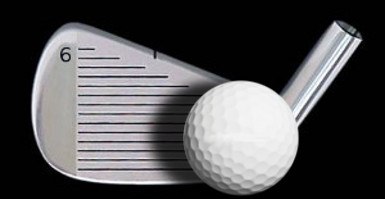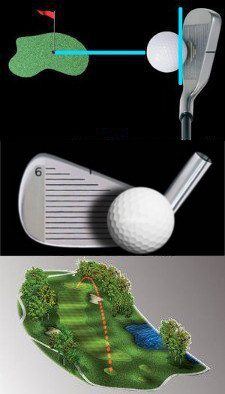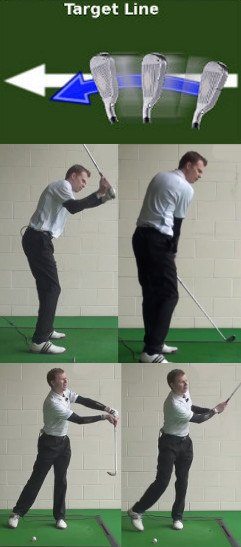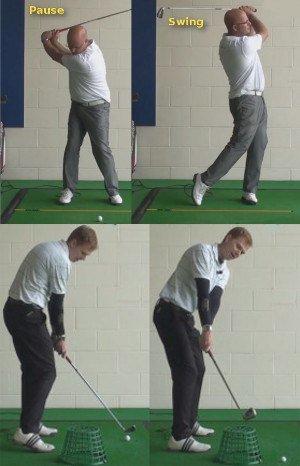While less common than hitting shots off the clubs toe (the end farthest from the shaft), heel shots still plague a wide range of golfers. Shots struck on this part of the club lack distance and accuracy. They also send an unpleasant, clunky sensation into the hands and – worst of all – can be a signal that the dreaded shanks are coming soon.

Consistently making contact with the club’s heel in golf is not an ideal ball strike. Those who suffer from this will ultimately see a high spinning ball flight with very limited distance. It becomes even more frustrating in windy conditions and it’s not even worth our time talking about the suffering in wet conditions.
Each time you swing the club, your goal is more or less the same – you want to strike the ball as near to the sweet spot as possible, in order to send the ball toward your target with the perfect combination of power and accuracy. When you do strike the ball on the sweet spot, you know it immediately. It’s a great feeling, and one every golfer dreams of repeating as often as possible.
| GOLF FIXES BY PGA PROS |
|---|
| Causes and Cures: Shots Off the Club’s Heel | Video | Article |
| Early Extension Causes Heel Hits | Video | Article |
| Fix my Shank Swing Problem Ball Hits on the Heel | Video | Article |
| Hitting Golf Shots From The Golf Club Heel How To Correct The Problem | Video | Article |
| How to Fix My Golf Swing Problem – Ball Hits On The Heel | Video | Article |
| How To Cure Toe And Heel Divots During The Golf Swing | Video | Article |
| Cause And Cure Of Deep Toe Or Heel Golf Divots Golf Tip | Video | Article |
| Cause Of Unequal Toe And Heel Divots During The Golf Swing | Video | Article |
| LESSONS |
|---|
| Curing Heel Deep Divots And Strikes In The Golf Swing | Video | Article |
| The Danger Of Making Heel Impact With Your Golf Irons | Video | Article |
| Eliminate Heel Hits With A Flatter Golf Swing Plane | Video | Article |
| Top 4 Tips On Shots Off The Clubs Heel | Video | Article |
| Use Release To Solve Golf Wedge Heel Impact Problems | Video | Article |
| Hitting The Heel With Your Golf Driver | Video | Article |
| Hitting Toe Or Heel Divots During The Golf Swing | Video | Article |
| Release Club Toe Past The Heel | Video | Article |
| How To Adjust The Golf Swing For Toe And Heel Divots | Video | Article |
| PRACTICE DRILLS |
|---|
| Simple golf drill to Heel chipping ailments | Video | Article |
| GOLF QUESTIONS |
|---|
| Why do I hit my golf drives from the heel of the club | Video | Article |
| How can I stop hitting shots off the clubs heel? | Video | Article |
Of course, not every shot is struck on the sweet spot. In fact, hitting the sweet spot is the exception rather than the rule for most players. When you miss the sweet spot, you’ll be hitting the ball either in off the heel or out off the toe. It is those heel shots that we are going to discuss in this article. While you’ll never avoid heel shots entirely, limiting their frequency is a great way to take strides toward your goal goals.
All of the content below is based on a right-handed golfer. If you happen to play left-handed, please take a moment to reverse the directions as necessary.
— What Happens When You Hit the Heel?
For an experienced golfer, it is pretty easy to tell when you have hit a shot off the heel of the club. The contact won’t feel as ‘clean’ as when you hit the sweet spot, and the club may even turn a little bit in your hands as you go through impact. The feeling is similar to when you miss out toward the toe, only this time the club will want to turn in the other direction – the toe will want to turn down if you have struck the ball on the heel.
Even if you don’t have a lot of experience, and aren’t able to feel your shots accurately, you’ll still know something went wrong. The sound of the ball coming off the club will be a little different than on a solid strike. As you continue to practice and play, you’ll get more and more familiar with how these shots feel so you can identify them immediately.
So, what kinds of outcomes should you expect when you hit a shot off the heel? Let’s take a look at some possibilities.

- Loss of distance. This one is nearly a certainty. When you hit the ball on the heel of the club face instead of the sweet spot, that shot is almost certain to travel shorter than you had planned. For instance, if you are able to hit your driver in the 250-yard range when you strike it on the sweet spot, you might only get 225-yards out of it when you hit the heel. Of course, the exact amount of distance you lose will depend on many factors, including the club you are using, the degree of the miss-hit, the conditions of the course, and more. Generally speaking, the distance you lose will be greater as the clubs get longer. You’ll lose quite a bit on a driver swing when you hit the heel, but you may lose very little – just a yard or two – on a wedge shot. Part of making your way around the course successfully comes down to using good course management strategy and understanding that you aren’t going to cover your full distance on every single swing. Some of your shots will be miss-hit slightly, so try to pick shots that will turn out okay even if you don’t quite cover the full number. This won’t always be possible, of course, but do your best to making smart decisions that give you as much margin for error as possible.
- Miss the target. Not only are you likely to lose distance when you strike a shot on the heel of the club, but you are also likely to see that shot head somewhere other than your intended target. The degree that you miss the target will depend on a number of factors, including the club you are using and how badly you miss-hit the shot. With a driver, you are likely to produce a fade when you hit the heel – so a miss to the right of the target would not be surprising. The only good news here is that since you haven’t hit the ball solidly, you aren’t going to get a ton of distance out of the shot. So, if it is flying off target, at least it shouldn’t go too far before it comes down.
- Lower trajectory and reduced spin. When you don’t catch the ball cleanly on the sweet spot, you aren’t going to get the expected amount of backspin on the ball – and you won’t hit the shot quite as high as a result. It is spin that allows the ball to soar high in the air, so missing out on some of your expected spin means that you won’t hit the heights you expected. And, of course, the ball won’t stop as quickly when it lands, since you have a flatter trajectory and a lower spin rate. Believe it or not, all of these elements can actually come together to lead to a good outcome if you get a little lucky. For instance, imagine a mid-iron approach shot to a hole cut in the back of the green. You are planning to hit the shot all the way to the target in the air, using spin to stop the ball quickly after it lands. By hitting it off the heel, you lose some distance, so the ball lands closer to the front of the green than the back. However, with a flatter flight and less spin, that shot might run out and wind up close to the hole after all. It won’t work out like this every time, of course, but you can get away with this kind of miss on occasion.
It’s not good news when you hit the ball on the heel of the club. However, you aren’t necessarily doomed to be pulling another ball out of your bag to try the shot again – sometimes, heel shots will work out just fine. Let’s move to discuss what it is that leads to heel shots so you can start working on making sweet spot contact more frequently.

— Common Problems That Lead to Heel Shots
Every golf swing is unique. Even if you have tried to model your swing after your favorite professional golfer, or if you have followed the mechanics recommended by an instructional book, your swing is still all your own. So, it’s always difficult to pinpoint what is causing a golfer to make a mistake like hitting the heel of the club, since there are so many variables at play.
With that statement made, there are some common errors that lead to heel shots, and we’d like to highlight them below. As you read through this section, think about your own swing to figure out whether or not one of these issues is causing problems in your game.
- Standing too close to the ball. This one might be rather obvious, but it’s important to point out anyway. If you are standing closer to the ball than necessary at address, you might not have room to swing through without striking the heel instead of the sweet spot. Not only will standing too close to the ball put you at risk for heel shots, but it might also cause you to struggle with your rotation through the hitting area. The right distance from the ball is going to vary from player to player, but you want to make sure you have enough space to turn through aggressively without crowding yourself at impact. Experiment with different stance positions on the range until you find a spot that is comfortable and leads to good results.
- An over-the-top move. You may already be familiar with one of the other problems that can come from an over-the-top swing – the slice. This is an issue that affects millions of golfers, so you rarely have to look far on the range to see someone swinging the club over-the-top. Not only can this error lead to the dreaded slice, but it can also cause you to strike too many of your shots near the heel of the club. When you swing over-the-top, you put the club outside of the correct path before pulling it back in toward your body as the downswing develops. If you don’t quite get all the way back into position by impact, you’ll strike the shot on the heel. Of course, with a bad over-the-top swing, hitting the heel may be the least of your problems, and you will likely be dealing with a pretty nasty slice as well.
- Poor balance. When talking about problems in the golf swing, so many topics make their way back to poor balance. If you don’t remain nicely balanced during the swing, it’s always going to be hard to achieve a clean strike on the sweet spot. In this case, the issue is moving your body closer to the ball as the downswing unwinds. Commonly, the player will lean back a little bit during the backswing, moving away from the ball and onto their heels. Then, when the downswing starts, that move is reversed, and the player moves his or her weight onto their toes. As a result, the upper body gets closer to the ball and the player is cramped through the hitting area. It’s going to be hard to hit good shots with this kind of move, and you might wind up striking the heel of the club as a result. During practice, work on staying nicely balanced throughout the swing, keeping your weight roughly in the middle of your feet. If you can improve your balance, it’s highly likely that you will improve your ball striking quality at the same time.
When trying to cut down on the number of heel shots you hit during a given round, you should be focused on the basic fundamentals of your swing. As you can see from the points above, it is the basics that will allow you to improve the quality of your ball striking. Your stance, your balance, and the path of your swing all play an important role here. Of course, if you do improve on your performance in these fundamental areas, your game is likely to improve as a whole.
— Two Helpful Swing Drills
Countless golfers head out to the driving range with the best of intentions – only to struggle to figure out how to work on the issues in their swing. In the end, many players wind up simply swinging away on the range, because they don’t know what they should be working on, or how to work on it. For this reason, it’s a good idea to have some drills in mind when you visit the range. By starting with some basic drills, you can move in the right direction and hopefully improve your performance over time.
The two drills listed below are easy to perform and will hopefully help you improve the quality of your contact at impact.

- Pause at the top. This is an excellent drill for a variety of purposes, including improving the quality of your contact. One of the things you should always look for in a golf swing drill is simplicity – and this one hits the mark on that point. All you will need for this drill is a golf club to swing. In fact, you don’t even need to be at the driving range, since you won’t be hitting any balls while doing the drill. Just find a safe place to make some practice swings and get started. Take your stance as usual and make your backswing just like you would for any normal shot. However, when you reach the top of the swing, pause and hold your position to the best of your ability. If you are properly balance, you shouldn’t have much trouble holding this position for a few seconds. On the other hand, if you have drifted off balance during the backswing, that mistake will quickly become evident when you try to stop. As we discussed above, it’s relatively common for golfers to drift away from the ball in the backswing, so you might feel as though you are leaning back when you try to stop at the top. If that is the case, work on improving your technique so you can remain nicely balanced all the way through the backswing. After you have paused for a couple of seconds at the top, go ahead and proceed with your downswing and then start the drill over again. If you are at the driving range, go ahead and hit some practice shots with your regular swing after you have completed this drill a few times.
- Roll straight back drill. With this drill, we are going to address an issue that can lead to an over-the-top move in the transition. Many golfers make an over-the-top swing, and a large percentage of those swings include a faulty takeaway. By using this drill, you should be able to improve your takeaway, and you may sharpen your ball striking as a result. For this drill, you’ll want to use a mid-iron and a golf ball – but you aren’t actually going to be hitting that ball. Instead, you will take your stance and position the club in front of the ball, rather than behind it. Then, start your swing and attempt to roll the ball straight back away from the target you have selected for this practice swing. Your goal is to roll the ball straight back without pulling it to the inside. If you use your hands and wrists too actively during the takeaway, you’ll likely pull the ball to the inside of the target line and you will be setting yourself up for an over-the-top swing. Do your best to keep your hands and wrists quiet in the takeaway and you should start to see the ball roll straight back away from the target. This kind of takeaway will put the club in a better position as the downswing moves along, and you might be able to avoid your over-the-top move as a result. Even if this drill doesn’t completely wipe out your over-the-top swing, it should at least reduce the severity and help straighten out your ball flight.
Give each of these drills a try and see what they may have to offer your game. Remember, golf isn’t about solving everything all at once – it’s about making small, incremental changes over the long run. If these drills can help move you in the right direction they will be well worth the effort and time required.
— Heel Shots on the Greens
You probably think first about your full swing when trying to dial in the quality of your ball striking, but it’s just as important to make great contact when putting. Putting well is largely about distance control, and it’s hard to control your distances if you aren’t hitting the ball with the center of the putter face. Fortunately, since putts require smaller swings and less speed, it’s actually easier to make great contact – as long as you have solid fundamentals and put in plenty of practice.
The list below highlights three keys to watch for as you work on dialing in your strike with the putter.

- Proper setup. This one might sound obvious, but you need to make sure you are setting up with the club in the right position behind the ball at address. While some players actually like to line the putter up in an off-center position before starting the stroke, that method is only going to complicate things for most average golfers. As you practice, pay attention to lining the putter up accurately behind the ball before the stroke begins. If you start in the right position, you’ll then only need to make a simple, repeatable stroke to hit the ball on the sweet spot over and over again.
- No head movement. If there is one issue that is to blame for missing the sweet spot more than any other, it’s excessive head movement. Countless players allow their heads to move during the putting stroke, especially as the moment of impact nears. Resist the temptation to move your head early and keep it as still as possible as the putter swings. To a large extent, the quality of your putting stroke will be determined by the stability of your head during the stroke. If your head stays still, the rest of your body should stay relatively still, and the putter should swing right down the target line. It is really the basic fundamentals that matter most on the greens, and keeping your head still is at the top of the list.
- Light grip pressure. This is a commonly overlooked, yet extremely important, piece of the putting puzzle. To allow your putter to swing freely, and accurately, through the hitting area, do your best to maintain a light grip pressure on the handle of the putter throughout the stroke. If you grip the club too tightly, your hands and wrists will have more control over the putter, and they may cause it to veer offline. Also, it’s harder to control the distance of your putts with a tight grip, so relaxing your hands should help on that front, as well. Spend plenty of time practicing on the putting green with a light grip so you are comfortable with this approach when you play your next round.
You’ll never completely eliminate heel shots from your game, but that’s okay. Rather than trying to be perfect – which isn’t going to happen – you should just be striving for gradual, steady improvement. And, even if you keep hitting some of your shots off the heel, moving those misses closer to the sweet spot will improve your results on average. We hope the content in this article will help you improve your ball striking in the near future.






